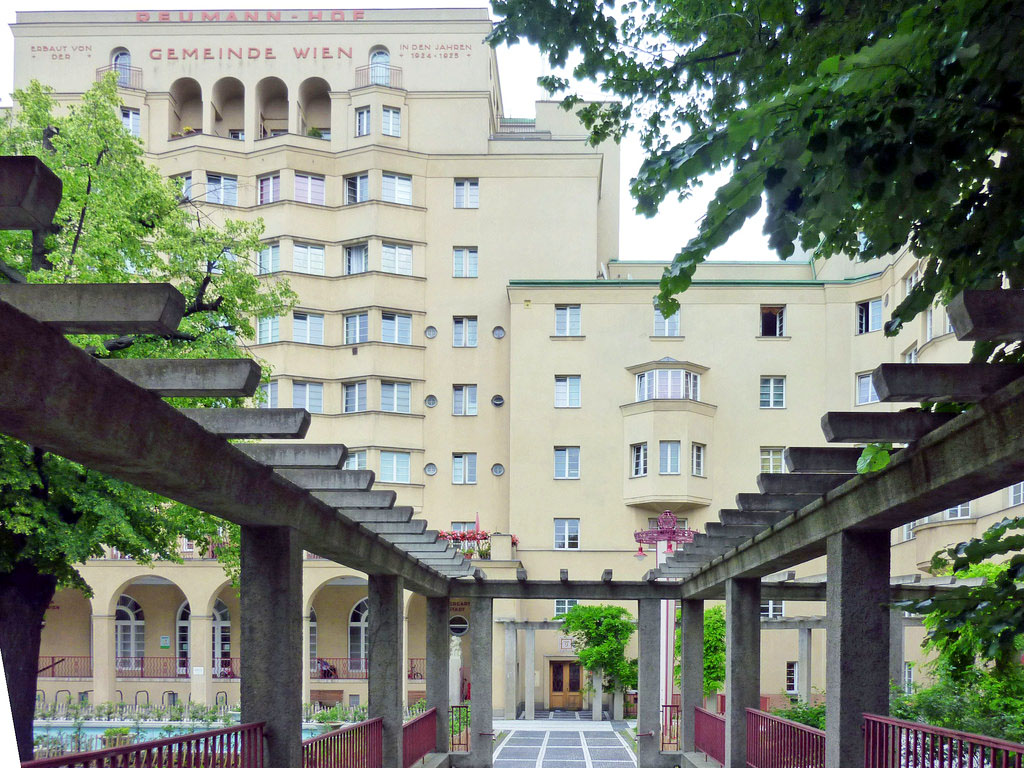It’s hard to admit a healthy Vancouver housing market may never come back. As evidence of market failure becomes more and more apparent, we look to Vienna, where over 60 per cent of its residents live in city-built, sponsored or managed housing.
How does this work? Can it be replicated elsewhere?
Nothing happens overnight, so let’s take a look at the long evolution of the Vienna model, which begins exactly 100 years ago.
Vienna in the landlord’s day
Vienna, during the last days of the Habsburgs, demonstrated its wealth in the form of impressive building façades.
But behind the façades was a grimmer reality: workers crowded 10 to a 300-sq.-foot flat. Many slept four to a bed. Some workers used their beds in shifts, hiring out sleeping space during the day while the principal tenant was at work — all to pay the usurious rents. Are we heading this way?
This Vienna was a city run by and for the landlords, wealthy owners of lands that had once been farms but now sprouted apartment buildings. Males of wealth, most of them landlords, were the only residents who could vote; they numbered 60,000 of Vienna’s two million residents at the dawn of the First World War.
With public policy so heavily tipped to landlords, renters had no protection. One-month leases were common and rents could be raised at any time with no recourse. Evictions were immediate, without cause and without adjudication.
The gravity of this housing crisis and the plight of the people can be measured by the number of the homeless. In 1913, over 461,000 people lived in asylums (homeless shelters by another name), an astonishing quarter of the population. About 29,900 of these homeless were children.
While what Vancouver is now experiencing is nowhere near this bad, there are echoes.
Here, the development industry wields outsized power over our elections, land speculators are reaping the benefits of our collective city-building efforts, homelessness is on the rise and wage earners are experiencing housing stresses that force them to accept insecure accommodations in crowded dwelling units.
When Austria and its allies were defeated in the First World War, the Habsburg monarchy collapsed. Universal suffrage followed; voting rights, once held by only two per cent of the population, were now granted to all, regardless of income or gender. This coincided with a dramatic leftward shift in Vienna’s politics, but in an unusual form.
The war was unkind to both victors and vanquished, destabilizing democracies and monarchies alike. The Russian Revolution and subsequent 75-year reign by communists is the most well-known consequence, but many other governments were similarly destabilized.
For the next generation, citizens throughout Europe separated themselves into political camps ranging from Marxist internationalists on the far left to fascist nationalists on the far right, unleashing inevitable internal conflicts and the eventual conflagration of the Second World War. Austria’s political trajectory was more moderate — but only at first.
The Viennese political left gained power with universal suffrage and the fall of the Austro-Hungarian Empire, and it retained this power until global economic constraints and the rise of Italian and German fascism led to a fascist takeover of the Austrian government in 1934. The relatively short period between 1917 and 1934 is called the “Red Vienna” period for the socialist leanings of its city leaders.
Significantly, elected and appointed officials during the Red Vienna period — unlike leftist parties in other parts of Europe — never set out to remove or even cripple capitalism by nationalizing property. Instead, they used a taxing strategy to meet their social ends and their most important achievement was providing decent housing for every resident.
How did they do it?
The city-developer
A number of policy and taxing policies made Vienna’s housing system possible.
Even before the Red Vienna period, a key policy was imposed that was crucial to the city’s later success: strict rent control. The government had imposed it to prevent war wives from being evicted while their husbands fought at the front. It was never repealed. The government outlawed raising rents beyond a minimal amount and, in the presence of extreme currency inflation, made it less profitable to build new rental stock.
Ordinarily, this would be a very bad thing for affordability, as rental stock is usually less expensive per month (in the short term at least) than home ownership. Thus, policies that impede the construction of rental housing are generally frowned upon. This is true here in Vancouver, where successive city governments have gone to herculean lengths to induce the private market to produce new rental stock — through subsidy, relaxed development taxes or density bonuses. The city has been nominally successful, reversing a decades’ long decline in purpose-built rental starts; but the monthly rents charged for these new market-rate units are unaffordable for all but the upper tier of renters.
Vienna provides an interesting counterpoint. Because rent control disincentivized the private development of rental buildings, landlords were, for a time, removed from the market for urban land. Consequently prices finally went down, allowing the city to buy land at a much reduced price; often it was the only buyer in the market.
The city quickly became the dominant developer of new housing. Vienna had the wisdom to retain the city’s best architects and developers to design and build the new projects, employing experts who had honed their skills in service to the private sector to build non-market housing.
A fifth of Vienna’s new housing built during the Red Vienna years was social housing for the poor and disabled. But the bulk of the new housing was for wage earners and their families, to be owned and managed by co-operatives or non-profit housing corporations. Non-profit housing corporations operate just like for-profit housing corporations, except that their profits are poured back into operations and they are obligated to keep rents in line with incomes.

Housing democracy
Even though the city was able to keep land prices down, land and housing still cost money. In the late 1920s, about 30 per cent of Vienna’s annual budget was spent buying land and financing housing construction.
Where did that money come from? Mostly from taxes on private property and land. They were levied on private apartment buildings and progressively increased with the assessed value of each unit. Very high taxes were also levied on vacant land, giving owners extra incentive to sell.
These policies stripped land speculation out of the marketplace and did so very rapidly. Doubtless, any attempt to replicate the Vienna strategy where faith in the “free market” remains strong would provoke emotional debate. But the gravity of the housing crisis that Vienna faced, and the efficacy of their solution, is beyond dispute. Is Vancouver approaching this same point?
Taxes supporting housing were eventually more broadly distributed, including a portion of income taxes now dedicated to housing. Resident Viennese had no problem supporting these taxes because they received secure housing that’s much more affordable than most of the developed world. Rents in Vienna are a quarter that of similar units in Paris.
Vienna also developed a system for working with non-profit development corporations that compete with each other for city sponsored projects. The city acquires the land for a project, establishes the housing goals and project pro forma and publishes the amount of financial subsidy to be supplied. Stakeholder groups judge the proposals submitted in response and decide which project team of architect, builder, developer and management entity has the most intelligent response.
This competitive process ensures that projects are distinctive and varied — a dramatic departure from the process for building public housing in many other countries, where mediocrity would seem to be the goal.
Perpetual affordability
Vancouver has been called the world’s most unaffordable housing market, at least by some measures. Vienna’s housing innovation was spurred by its own housing crisis a century ago. Is it time for Vancouver to act and build many thousands of non-market housing units?
It would be a favourable time to do so. The provincial and federal governments are poised to support affordable housing once again, a responsibility largely abandoned since the 1990s. Vancouver has a strong claim to funds from these higher levels of government, given that it is B.C.’s main engine of economic growth and Canada’s third largest urban centre.
What can we learn from the Vienna example?
Vienna treats land like the precious community asset that it is. We can acquire and keep land in the hands of the people who live on it. We should never sell city-owned land. And like Vienna, it would be crucial for Vancouver to purchase more land on behalf of non-governmental housing providers, whether they be churches, co-ops or charitable organizations.
The city also has powerful levers like zoning regulations and development taxes. Currently, Vancouver collects taxes on development through development cost levies and community amenity contributions.
In the past, these taxes have been reduced to incentivize the creation of market-rental units that developers would not otherwise build because of high land costs.
But that strategy is both inefficient and fails to ensure affordable housing in perpetuity. Community amenity contributions and development cost levies can and should be retargeted, and increased as much as possible, to provide funds for non-market housing and to reduce speculative pressures on development lands. Together with these revenues and provincial and federal funds, the city could jumpstart the creation of non-market housing for city wage earners in the bottom half of the income scale.
Taxpayers need not worry. With an initial period of subsidy, intelligent land use controls and policy and taxing levers, a sustainable housing system can be built that would eventually return the money back to the public sector — and thus the taxpayer. Assuming Vancouver wage earners continue to earn a reasonable salary, they can certainly pay a third of their earnings for housing, and thus repay construction financing and maintenance costs.
The Vienna model gives us hope for a housing system that can still align with average incomes in the face of global speculative pressures on land. Far from closing out the free marketplace, the Vienna model shows that they can complement each other. Development land is still cheap in Vienna (relative to Paris, at any rate) for both the city and for private developers. It is precisely the presence of the city in the land market that keeps it this way. The best Viennese developers work with the city to build outstanding housing projects one year and for private interests the next.
The result: a city with an outstanding, successful model for creating more non-market and market affordable housing.
As both the Vienna model and Henry George would suggest, the problem is forever and always the cost of land. Burdensome land costs, and the rentiers who gain massive wealth by passive land speculation, are the real enemies — not developers, not our homeowners, not our public officials.
A plan to house up to half our wage earners in decent homes protected from the vagaries of the unshackled land market is our only choice if we are committed to avoiding the fate of Monaco, a pretty place to park money and visit every now and then.
If we don’t want Vancouver to go down this path, then perhaps we should heed Henry George’s advice: tax land and use the proceeds to build the housing we need.
This concludes Patrick Condon’s three-parter on land and housing. Are these solutions bold enough to address Vancouver’s housing crisis? Or are they too bold to be put into practice? Comment below, or refresh yourself by rereading the series here.
Read more: Housing, Urban Planning

















Tyee Commenting Guidelines
Comments that violate guidelines risk being deleted, and violations may result in a temporary or permanent user ban. Maintain the spirit of good conversation to stay in the discussion and be patient with moderators. Comments are reviewed regularly but not in real time.
Do:
Do not: